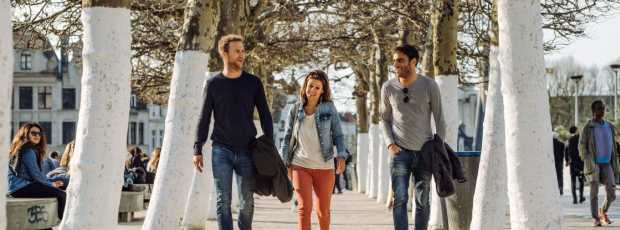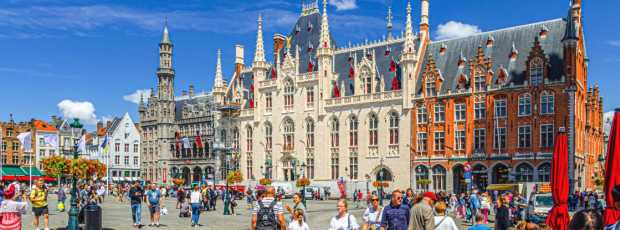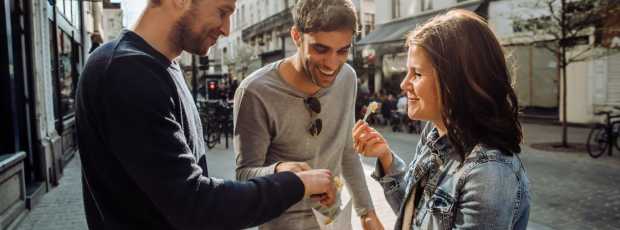Table Of Contents
- What's Happening in Brussels Today?
- Where Should You Start Your Brussels Adventure?
- Museums That Don't Feel Like Tourist Traps
- Secret Spots Where Brussels Locals Hang Out
- Brussels After Dark: More Than Just Beer Halls
- Where to Experience Real Brussels Culture
- Food and Drink Beyond the Tourist Trail
- Neighborhoods Worth Exploring Today
- The Brussels Food Scene That Guidebooks Don't Tell You About
- Brussels Markets: Beyond the Obvious Tourist Traps
- Art and Culture That Matters Today
- Practical Tips for Brussels Today
- Beyond the Expected Attractions
- Weather-Proof Brussels: What to Do When It Rains (Spoiler: It Will)
- Making the Most of Your Brussels Experience
- The Brussels Most Tourists Never See: Industrial Heritage and Urban Art
- The Brussels Experience That Matters
I'm Camille, and I've been watching this city evolve from a sleepy European capital into something much more interesting. Yes, we have Manneken Pis and tourists still queue for photos. But if you want to understand what makes Brussels tick today, you need to dig deeper than the surface attractions.
What's Happening in Brussels Today?
Is there anything special going on in Brussels right now?
The beauty of Brussels is that something interesting is always happening if you know where to look. The city of Brussels has this wonderful way of surprising you with pop-up exhibitions, impromptu concerts, and cultural events that locals stumble upon rather than plan for.
Right now, the European Quarter is buzzing with activity beyond the usual European parliament business. There's a growing contemporary art scene in the former industrial buildings, and the Saint-Gilles neighborhood has become a hub for young artists and musicians. The BELvue museum recently opened new sections of their permanent exhibition, and the Brussels city museum in the King's House overlooking Grote Markt has been quietly rotating some fascinating displays.
Where Should You Start Your Brussels Adventure?
What's the best way to begin exploring Brussels today?
Forget starting at Grand Place like everyone tells you to. Sure, it's stunning, but it's also where every tour group begins at 9 AM. Instead, start at the Saint Hubert galleries early in the morning when the light filters through the glass ceiling and the coffee shops are just opening their doors.
The Royal Gallery of Saint Hubert isn't just a shopping arcade, it's where Brusselois go to drink their morning coffee and read the news. The Tropismes Library located inside has one of the most beautiful interiors in the city, and you'll find locals settling in with books before the day gets busy.
From there, walk down toward the Marolles district. This is where the real Brussels begins, narrow streets lined with antique shops, bars that have been serving Belgian beer since before the European Union existed, and restaurants where the menu is still written in French and Flemish only.
Looking for a private city experience in Brussels?
Explore the city with a local who plans a private day just for you; no groups, no scripts.
Museums That Don't Feel Like Tourist Traps
Which museums in Brussels are worth visiting today?
Magritte Museum:
This museum features the world's largest collection of René Magritte's work, including paintings, gouaches, drawings, and sculptures.
Old Masters Museum:
This museum houses a vast collection of paintings, sculptures, and drawings from the 15th to the 18th centuries, showcasing works by prominent artists like Memling, Bosch, Bruegel, Rubens, and Van Dyck.
Meunier Museum:
This museum is dedicated to the works of Belgian sculptor and painter Constantin Meunier. It features a collection of his sculptures, paintings, and drawings.
Royal Museums of Fine Arts of Belgium:
This umbrella organization encompasses several museums, including the Ancient Art Museum and the Modern Art Museum, which contain a wide range of sculptures alongside paintings and other artworks.
The Comics Art Museum (Centre Belge de la Bande Dessinée):
Housed in a magnificent Art Nouveau building designed by Victor Horta. It offers a comprehensive journey through the history and diverse styles of comic strips, celebrating Belgium's rich heritage in the art form.
What about the smaller museums?
The BELvue museum tells the story of Belgium and the Belgian royal family in a way that's engaging. Their new location sections focus on contemporary Belgium rather than just history, and the permanent exhibition includes interactive elements that make the middle ages feel relevant today.
The Brussels City museum in the bread house (that's the King's House on Grote Markt) has been completely reimagined in recent years. Instead of dusty displays, they now focus on how the city evolved and what makes Brussels unique in Europe today.
Don't miss the history museum sections that connect Brussels' past to its present role in the world. The today houses around Grand Place tell stories that span centuries, from medieval guilds to modern European governance.
Secret Spots Where Brussels Locals Hang Out
Where do real Brusselois go to escape the crowds?
The Parc du Cinquantenaire isn't just about the museums, locals use the tunnels underneath for impromptu art installations and music sessions. The Bois de la Cambre becomes a completely different place after sunset, when students and artists gather around the lake.
What hidden gems do tourists completely miss?
The Galerie Bortier is Saint Hubert's forgotten sibling, a narrow Art Nouveau passage filled with antique book shops and print galleries. The Sablon district transforms after restaurant hours into a neighborhood where locals live, not just visit.
Brussels After Dark: More Than Just Beer Halls
What happens in Brussels when the sun goes down?
The night scene here isn't about tourist bars, it's about underground concerts in former industrial buildings, late-night galleries that open their doors for wine and conversation, and 24-hour cafés where locals write, read, and debate until dawn.
Where do locals go for memorable nights out?
Recyclart under Central Station transforms railway arches into performance spaces. C12 in a former church hosts electronic music events that attract locals from across Europe. These venues understand that nightlife is about community, not just consumption.
What if your day in Brussels was planned by someone who knows it — and you?
City Unscripted matches you with a local host who creates a private experience based on your interests, not a set route.
Where to Experience Real Brussels Culture
What cultural experiences should you prioritize in Brussels?
The Art Nouveau architecture tour that everyone talks about is fine, but locals know that Victor Horta and architect Jules Brunfaut created buildings that are still lived in and used today. Walk through the Saint-Gilles neighborhood and you'll see Art Nouveau houses where people live, not just preserved monuments.
Music happens everywhere in Brussels. The Ancienne Belgique gets all the attention, but the concerts happen in smaller venues like Botanique or the pop-up events in former industrial spaces. Check what's happening at Beursschouwburg, they program contemporary art installations alongside music performances.
How do locals spend their evenings?
We don't queue for Delirium Café with its thousand-beer beer list. Instead, we go to neighborhood bars where the bartender knows our name and serves Belgian beer from small breweries you've never heard of. Café Central in Saint-Gilles has been serving locals since the 1920s, and Moeder Lambic curates a selection that changes with the seasons.
For something different, the Beer Museum near Grote Markt offers tastings that go beyond the typical tourist experience. They focus on craft breweries and the cultural significance of beer in Belgian society.
Food and Drink Beyond the Tourist Trail
Where do Brussels locals eat and drink?
The restaurants around Grote Markt are designed for people taking photos, not for people who want to eat well. Locals head to rue Dansaert for contemporary takes on Belgian classics, or to the Marolles for bistros that haven't changed their recipes in decades.
Coffee culture in Brussels has evolved dramatically. While tourists queue for waffles and chocolate, locals have embraced specialty coffee shops like OR Coffee and Café Costume. These places understand that good coffee is about the experience, not just the caffeine.
What about the famous Belgian chocolate?
Skip the hotel concierge recommendations and head to Pierre Marcolini or Wittamer, chocolatiers who create for locals, not tourists. The Galeries Royales Saint-Hubert houses several chocolate shops where you can taste before you buy, and the shop owners still know their craft.
Neighborhoods Worth Exploring Today
Which Brussels neighborhoods offer the most authentic experiences?
Saint-Gilles has become the cultural heart of modern Brussels. Artists live here, galleries open in former warehouses, and the bars serve drinks that reflect the neighborhood's diversity. The summer terraces fill with locals speaking French, Flemish, and half a dozen other languages.
Ixelles offers a different perspective on Brussels life. The Flagey building hosts concerts and exhibitions, while the Ponds of Ixelles provide a peaceful walk through an area that feels more like a village than a capital city.
What makes these neighborhoods special?
These areas have heritage without feeling preserved in amber. People live here, work here, and create here. The buildings tell stories of how Brussels evolved from a medieval city into a modern European capital, but they're not museums, they're homes and workplaces.
Tip
We match you with the right host, not just any guide.Want to experience the real Brussels with someone who lives there?
A fully private experience, planned and led by a local host who tailors the day to you
The Brussels Food Scene That Guidebooks Don't Tell You About
What culinary experiences define modern Brussels?
Forget the waffle stands and chocolate shops designed for tourists. The real Brussels food scene happens in Vietnamese restaurants in Matongé, Turkish bakeries in Schaerbeek, and Ethiopian coffee ceremonies in Saint-Josse. These communities have transformed Brussels into a multicultural culinary destination.
Where do locals go for authentic Belgian cuisine?
Chez Léon gets the publicity, but locals eat at Aux Armes de Bruxelles or family-run bistros in Uccle. The difference is in the atmosphere, these places cook for people who return weekly.
Brussels Markets: Beyond the Obvious Tourist Traps
Which markets offer genuine Brussels experiences?
The Midi Market on Sundays, is a large open-air market, a popular destination for both locals and tourists, offering a wide array of goods including fresh produce, meat, fish, flowers, plants, clothing, and other products from around the world. The market is known for its vibrant atmosphere and is considered a cosmopolitan experience due to the diverse range of nationalities present.
Some locals shop at smaller neighborhood markets like Place du Châtelain on Wednesdays or Parvis Saint-Gilles on Saturdays. These markets sell ingredients that reflect Brussels' diversity; Moroccan spices, Polish bread, Italian cheeses.
What makes Brussels markets special?
Market vendors remember regular customers and recommend seasonal specialties. The social aspect matters as much as the shopping, markets are where neighborhoods gather, gossip, and maintain community connections.
Art and Culture That Matters Today
Where can you see contemporary art in Brussels?
The Wiels center in Forest showcases artists who are shaping conversations about Europe today. Their exhibitions change every few months, and they often feature Belgian artists alongside international names.
The Botanique isn't just a music venue, it's a cultural complex where concerts, art exhibitions, and festivals happen simultaneously. The building itself is a heritage site, but the programming is thoroughly modern. The Saint Michael cathedral nearby often hosts classical concerts that locals attend for both the music and the stunning architecture.
What about the comic book culture everyone talks about?
The comic strip route through the city is fine for a walk, but locals know that comics culture in Brussels goes much deeper. Forbidden Planet and Multi-BD are where artists and collectors shop, and the Brussels Comics Festival in summer brings together creators from across Europe.
Ready to plan your perfect day in Brussels?
Start your experiencePractical Tips for Brussels Today
How should you navigate Brussels like a local?
Walking is still the best way to explore Brussels. The city center is compact, and streets that look intimidating on Google Maps are pleasant strolls. The tram system connects neighborhoods efficiently, and locals use it to visit areas beyond the tourist zones.
What about timing your visit?
Museums are less crowded in the late afternoon, bars fill up after 6 PM, and restaurants serve dinner later than you might expect. The Grote Markt is most beautiful early in the morning or late at night when the town hall and guild houses are illuminated without the crowds.
Beyond the Expected Attractions
What unique experiences does Brussels offer today?
The European quarter isn't just about politics, it's where international communities have created restaurants, shops, and cultural spaces that reflect Brussels' role as a European capital. Chez Léon may be famous for its mussels, but the Vietnamese restaurants in Matongé and the Turkish bakeries in Schaerbeek tell more interesting stories about modern Brussels.
Weather-Proof Brussels: What to Do When It Rains (Spoiler: It Will)
How do locals handle Brussels' unpredictable weather?
Rain in Brussels isn't a problem, it's an opportunity. There are covered passages like Galeries Royales Saint-Hubert, which connects major attractions underground. Tram shelters can act as temporary community spaces, and cafés transform into cozy indoor retreats.
What indoor activities do Brussels locals enjoy?
Cinematek shows films that commercial cinemas ignore. Library spaces like KBR offer exhibitions alongside books. Indoor markets like Halles Saint-Géry host events year-round, regardless of weather.
Making the Most of Your Brussels Experience
What should you prioritize in a day in Brussels?
Choose one neighborhood and explore it thoroughly rather than trying to see everything.
- Saint-Gilles offers Art Nouveau architecture, contemporary galleries, and excellent restaurants.
- Ixelles combines cultural attractions with local life.
- The Marolles provides history, antiques, and traditional bars.
How do you avoid tourist traps?
If there's a queue of people taking photos, that's probably not where locals go. If the menu is in four languages, the food is probably designed for tourists. If the prices seem too good to be true, you're likely in a tourist trap.
The Brussels Most Tourists Never See: Industrial Heritage and Urban Art
What parts of Brussels do guidebooks completely ignore?
Forest and Anderlecht have industrial heritage that tells Brussels' working-class story. Former factories house artist studios, community gardens, and cultural centers that represent contemporary Brussels better than any museum.
How has Brussels' industrial past shaped its present?
Canal neighborhoods still show traces of Brussels as a manufacturing center. Warehouse conversions house galleries, restaurants, and co-working spaces that attract young professionals and artists. This evolution happens organically, not through tourism planning.
The Brussels Experience That Matters
What makes Brussels special compared to other European cities?
Brussels doesn't try to be Paris or Amsterdam. It's a city where European institutions coexist with local neighborhoods, where medieval architecture houses contemporary art, and where traditional Belgian culture adapts to international influences.
The things to do in central Brussels that locals recommend aren't about checking off attractions, they're about understanding how this city works today. Whether you're exploring Art Nouveau buildings where people still live, visiting museums that engage with contemporary questions, or drinking Belgian beer in bars that have been serving locals for generations, Brussels offers experiences that feel authentic because they are.
What's the real Brussels takeaway?
Brussels today is a city that balances heritage with innovation, local culture with international perspectives, and traditional attractions with contemporary experiences. The best things to do in Brussels today aren't about following someone else's itinerary, they're about discovering what makes this city unique and why locals choose to call it home.
The Brussels experiences that matter most aren't the ones that look good on social media. They're the conversations with bartenders who remember your drink, the discoveries in galleries you stumbled upon, and the understanding that Brussels is a city where past and present coexist in ways that feel both natural and surprising.
That's what makes Brussels worth your time today, not because it's trying to be something it's not, but because it's completely, authentically itself.
What if your day in Brussels was planned by someone who knows it — and you?
City Unscripted matches you with a local host who creates a private experience based on your interests, not a set route.
Want to experience the real Brussels with someone who lives there?
A fully private experience, planned and led by a local host who tailors the day to you











